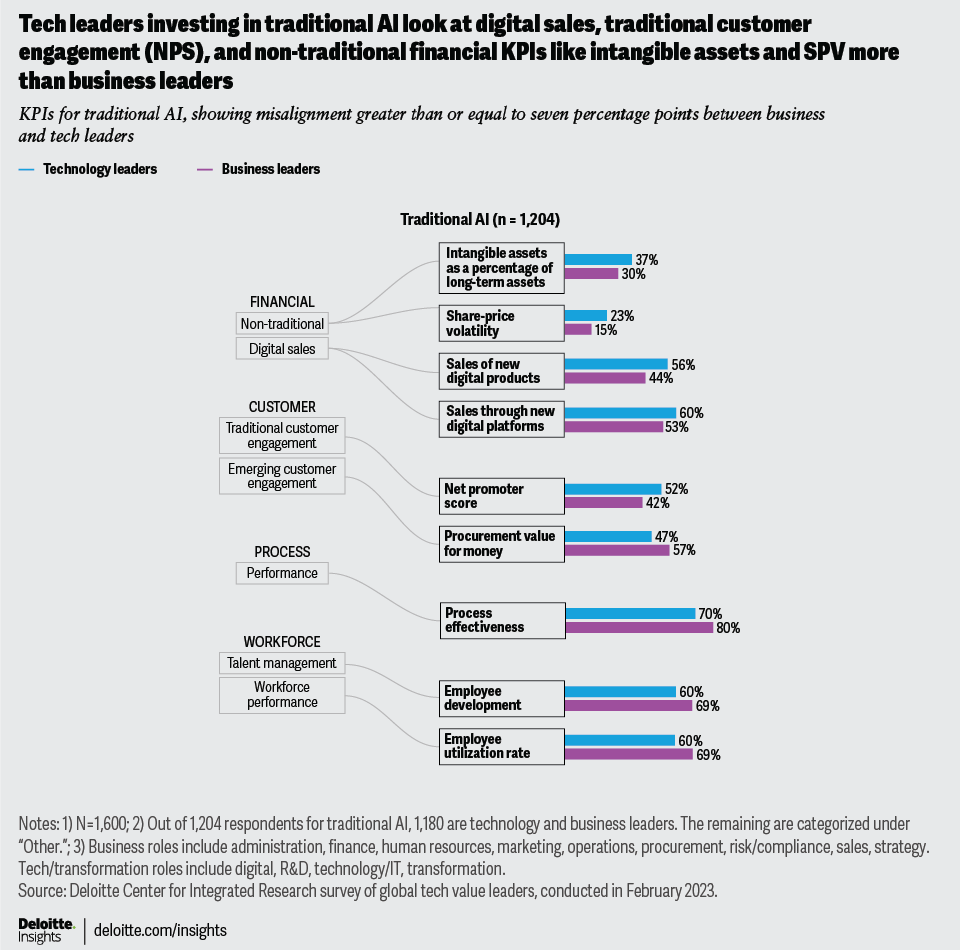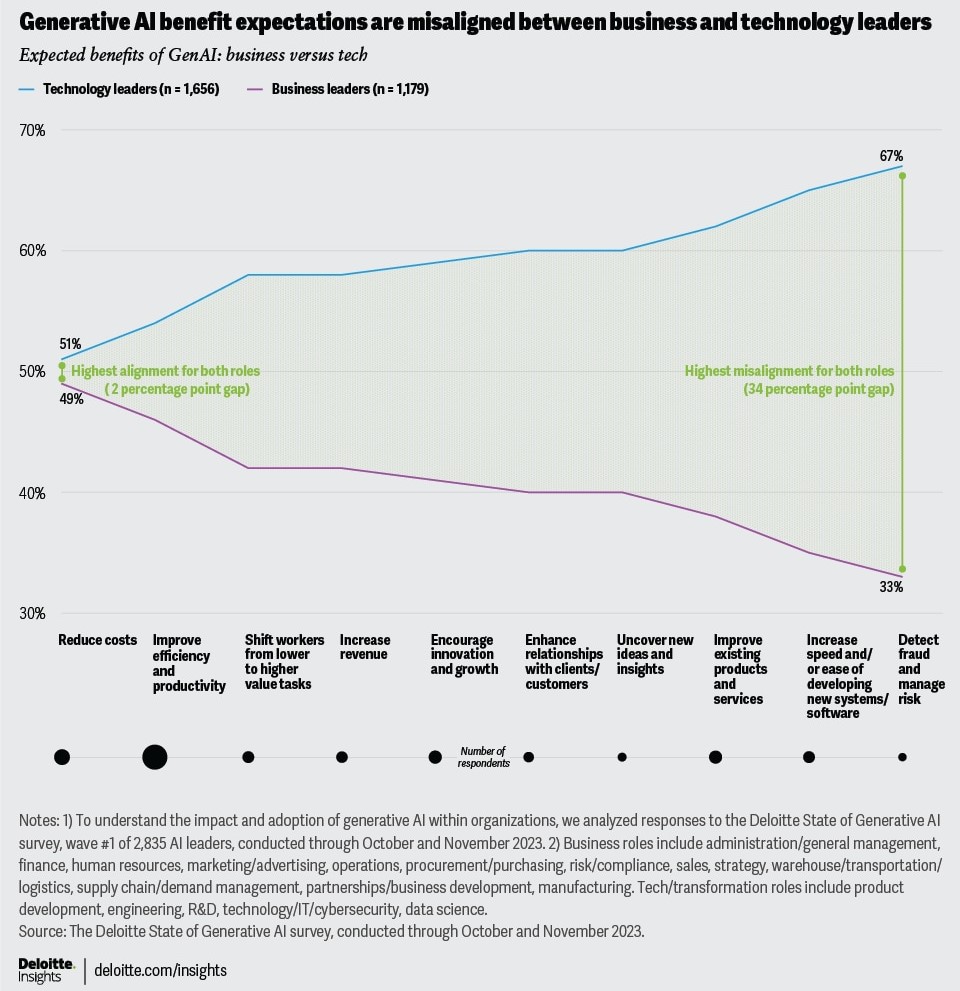Tech Harmony: Aligning AI, Cloud, and Cybersecurity Metrics

A major challenge today is the rising disparity in how business and technology leaders perceive and measure the full potential of emerging technologies
By bridging measurement divides and aligning expectations between business and technology leaders, organisations can unlock the full potential of emerging technologies, driving innovation, growth, and competitive advantage in the digital age.A major challenge today is the rising disparity in how business and technology leaders perceive and measure the said value. This can lead to misaligned expectations, hindering the effective allocation of resources and jeopardising the realisation of desired outcomes.

Figure 1: KPIs for Traditional AI; Source: Deloitte Insights
Understanding Measurement Disparities
Business leaders usually exhibit a broader perspective, emphasising KPIs related to business continuity and regulatory compliance, whereas technology leaders prioritise measures of organisational resilience and employee productivity.
- Variations in Measurement Behaviour: The distinct approaches to evaluating tech investments stem from differing priorities and perspectives between business and technology leaders. While technology leaders prioritise strategic outcomes such as sales growth and brand enhancement, business leaders tend to focus more on operational efficiencies and cost reduction. This disparity in KPI selection reflects the divergent lenses through which each group views technology investments.
For instance, technology leaders may emphasise metrics that directly contribute to business growth and competitiveness, while business leaders may prioritise metrics that streamline internal processes and optimise resource utilisation. Bridging this gap requires fostering a mutual understanding of the strategic and operational implications of tech investments, enabling organisations to develop comprehensive measurement frameworks that capture both business and technology perspectives.
- Tech Leaders’ Perspective on AI: The divergence in expectations regarding generative AI’s benefits underscores the need for business leaders to expand their understanding of the technology’s capabilities. While technology leaders are optimistic about AI’s potential to drive strategic advantages such as innovation and growth, business leaders may undervalue these aspects, focusing instead on more immediate operational benefits.
This disparity can result in missed opportunities for leveraging AI to achieve transformative outcomes. Business leaders must align their expectations with technology leaders’ insights, recognising AI’s potential to enhance not only efficiency but also creativity, agility, and competitive positioning. By embracing a broader perspective on AI’s value proposition, organisations can harness its full potential to drive innovation, growth, and sustainable competitive advantage in the digital age.

Figure 2: Expected benefits of GenAI; Source: Deloitte Insights
- Cloud Investment Lens: The differing perspectives on Cloud investments highlight the need for organisations to recognise both the tactical and strategic value of Cloud computing. While business leaders often prioritise back-office metrics like process effectiveness and cost reduction, technology leaders perceive Cloud’s larger potential in directly driving new revenue streams and enhancing customer experiences. This discrepancy in priorities reflects a fundamental difference in how each group perceives the role of technology in achieving business objectives.
To bridge this gap, organisations must foster collaboration between business and technology leaders, encouraging dialogue and shared understanding of Cloud’s multifaceted benefits. By aligning on strategic objectives and developing measurement frameworks that capture both operational efficiencies and revenue growth opportunities, organisations can maximise the ROI of their Cloud investments and accelerate their digital transformation journey.
- Cybersecurity Priorities: While business leaders emphasise risk mitigation and organisational resilience, technology leaders tend to focus more narrowly on defensive outcomes such as incident processing and attack detection. This difference in focus reflects varying perspectives on the role of cybersecurity within the organisation. Business leaders prioritise safeguarding business continuity and ensuring regulatory compliance, recognising cybersecurity as a critical enabler of business resilience and trust.
In contrast, technology leaders may be more concerned with technical aspects of cybersecurity, such as the efficacy of detection and response mechanisms. To address this disconnect, organisations must foster collaboration between business and technology leaders, ensuring that cybersecurity strategies align with broader business objectives and encompass both defensive and strategic priorities. By adopting a holistic approach to cybersecurity governance, organisations can effectively manage cyber risks and safeguard their digital assets.
Bridging the Gap
- Aligning Expectations: To bridge the gap between business and technology leaders’ value priorities, organisations must facilitate regular collaboration and communication. By bringing these two groups together, organisations can foster a shared understanding of strategic objectives and define common success measures for AI, Cloud, and cybersecurity initiatives. This alignment is crucial for maximising the ROI of tech investments and ensuring that resources are directed towards initiatives that deliver tangible business value.
Additionally, by establishing a collaborative decision-making process, organisations can leverage the collective expertise of both business and technology leaders to identify emerging opportunities and address evolving challenges in the digital landscape.
- Educating Business Leaders: Business leaders must broaden their understanding of technology’s strategic potential, particularly in areas like generative AI. By recalibrating their expectations to align with technology leaders’ insights, business leaders can unlock the full potential of emerging technologies to drive growth and innovation. This requires a proactive approach to education and awareness-building, with technology leaders playing a key role in facilitating knowledge transfer and sharing best practices.
Additionally, organisations should invest in training programs and resources to equip business leaders with the necessary skills and knowledge to effectively leverage technology for strategic advantage.
- Expanding Measurement Frameworks: Both business and technology leaders should adopt a more holistic approach to measuring tech investments, encompassing not only traditional financial metrics but also innovation indicators and long-term value creation. This requires organisations to evolve their measurement frameworks to capture the full spectrum of benefits derived from AI, Cloud, and cybersecurity initiatives. By incorporating a diverse range of KPIs, organisations can gain deeper insights into the strategic impact of tech investments and make more informed decisions about resource allocation and investment prioritisation.
Organisations should also embrace a culture of continuous improvement, regularly reviewing and refining their measurement frameworks to ensure alignment with evolving business objectives and technological advancements.
- Enhancing Cybersecurity Practices: Organisations must prioritise cybersecurity assessments to identify potential vulnerabilities and strengthen risk mitigation strategies. By undertaking independent cybersecurity assessments, organisations can gain valuable insights into their security posture and identify areas for improvement. This proactive approach to cybersecurity risk management enables organisations to address vulnerabilities before they are exploited by malicious actors, reducing the likelihood of data breaches and other security incidents.
Organisations should foster collaboration between business and technology leaders to ensure that cybersecurity strategies align with broader business objectives and encompass both defensive and strategic priorities.


